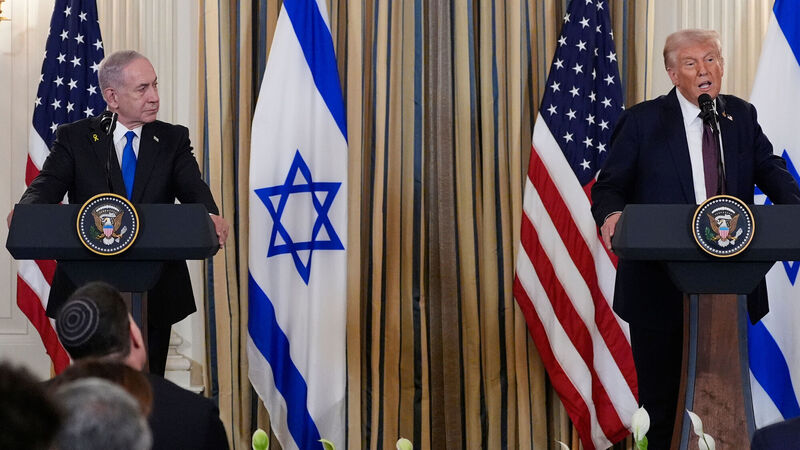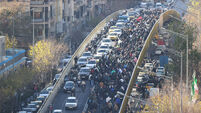ieExplains: What’s in Trump’s 20-point peace plan for Gaza?

US president Donald Trump speaks during a news conference with Israel's prime minister Benjamin Netanyahu in the State Dining Room of the White House, Monday, Sept. 29, 2025, in Washington. (AP Photo/Alex Brandon)
The White House peace plan for Gaza proposes an immediate end to the devastating war between Israel and Hamas that has raged in the coastal territory for nearly two years, while pointedly excluding the Palestinian militant group from any future governing role.
Assuming both sides agree to a detailed list of conditions, the end of fighting will be accompanied by the release of all Israeli hostages, both dead and alive, “within 72 hours” of Israel publicly accepting the deal.
In return for the release of hostages, Israel would release 250 Palestinians currently serving life sentences and 1,700 Palestinians in Gaza detained since the conflict started on 7 October 2023 after Hamas’ deadly attack on Israel. For every Israeli hostage whose remains are released, Israel will release the remains of 15 deceased Palestinians.
The plan does not require a full Israeli withdrawal ahead of the release of the hostages. Rather, Israeli forces would withdraw to an agreed upon line, inside Gaza, to prepare for a hostage release. The plan says that all military operations, including aerial and artillery bombardment, will be suspended during the release process and battle lines will remain frozen until “conditions are met for the complete staged withdrawal”.
Once all hostages are released, amnesty will be granted to members of Hamas – the Islamist military group that Israel’s prime minister, Benjamin Netanyahu, has repeatedly vowed to destroy – who agree to peaceful co-existence and to decommission their weapons.
Those who wish to leave Gaza will be given safe passage to countries who have agreed to receive them.
The 20-point plan envisages Gaza as “a de-radicalized terror-free zone that does not pose a threat to its neighbours”. In a separate point, it says the territory will be “redeveloped for the benefit of the people of Gaza, who have suffered more than enough”.
Vitally, and in defiance of the vision of some of Netanyahu’s far-right coalition partners, Israel will not occupy or annex the territory, which was home to 21 Israeli settlements before their inhabitants were withdrawn in 2005. Nor will anyone be forced to leave Gaza, the plan promises. Those who wish to leave will be allowed to do so freely and permitted to return.

Hamas will not be permitted any role, “directly or indirectly”, in the future governance of the territory.
As to the immediate future, the plan provides for “full aid” to be sent to Gaza, parts of which are suffering from famine and regular deaths from starvation.
“Entry of distribution and aid in the Gaza Strip will proceed without interference from the two parties through the United Nations and its agencies, and the Red Crescent, in addition to other international institutions not associated in any manner with either party,” the plan says.
The restoration of aid will mean the reopening of the border crossing at the southern Gaza city of Rafah, which has been largely razed by Israel.
With Hamas banished, Gaza’s governance would be passed to a temporary transitional body in the form of a “technocratic and apolitical Palestinian committee”, which would in turn be overseen and supervised by an international “Board of Peace”, headed by Donald Trump. The board would include other heads of state and international officials, including the former British prime minister, Tony Blair.
That body would organize and set the framework for funding the redevelopment of Gaza while the Palestinian Authority, the political entity nominally in charge of Palestinian affairs in the West Bank, had undergone a process of reform.
A panel of experts will be convened to create what the plan calls a “Trump economic development plan to rebuild and energize” the territory, which the US president has previously envisioned being transformed into a “riviera” with a string of hi-tech megacities.
Mention of the thorny issue of a future Palestinian state, which Netanyahu vehemently opposes, is left until the end of the plan, with “an interfaith dialogue process” to be set up to promote “the values of tolerance and peaceful coexistence”.
The aim is to “try and change mindsets and narratives of Palestinians and Israelis”.
Even then, a Palestinian state is held out only as a vague possibility. “While Gaza redevelopment advances and when the PA reform program is faithfully carried out, the conditions may finally be in place for a credible pathway to Palestinian self-determination and statehood, which we recognize as the aspiration of the Palestinian people,” the plan says.













